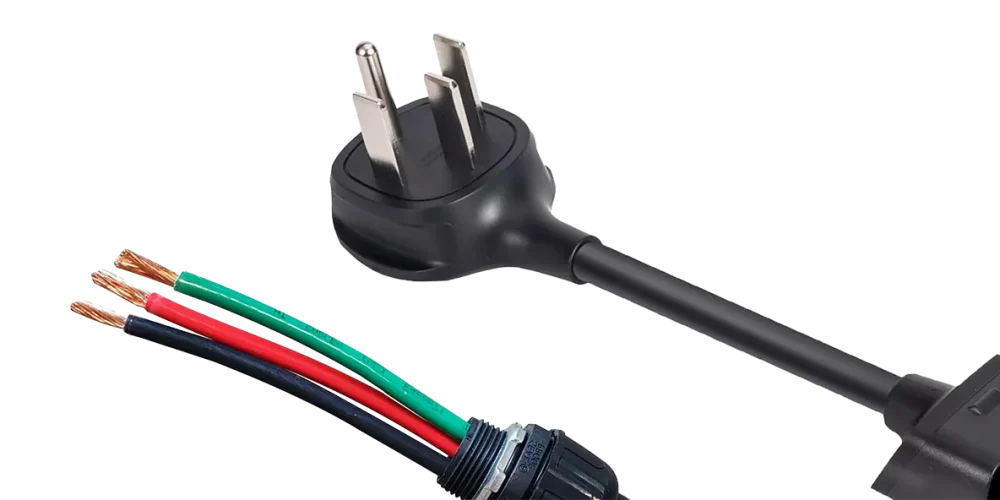
Pros, Cons, and Key Differences Between Plug-In and Hardwired Home EV Charger Installations
When installing an EV charger at home, one of the key decisions you’ll face is whether to choose a hardwired EV charger or a plug-in EV charger. Many EV charger models are available in both formats, and each comes with distinct advantages and trade-offs. Understanding the differences in a hardwired vs plug-in EV charger setup can help you make the best choice for your home and driving habits.
This guide will help you compare these two installation types based on wiring, safety, cost, flexibility, and long-term use.
What Is a Hardwired EV Charger?
A hardwired EV charger is permanently connected to your home’s electrical system via a dedicated circuit. The wiring runs directly from your electrical panel to the unit, with no plug or outlet in between. This method offers a clean, permanent installation ideal for homeowners looking for a long-term solution.
What Is a Plug-In EV Charger?
A plug-in EV charger connects to a high-voltage outlet—usually a NEMA 14-50 or NEMA 6-50—allowing the charger to be unplugged and moved if needed. While offering more flexibility, plug-in installations often come with higher component costs and more visual exposure. They are sometimes labeled as “DIY-friendly” if a compatible outlet already exists, since the user may be able to install the unit without modifying the electrical panel. However, this depends heavily on local code and the quality of the existing outlet.
Pros and Cons
✅ Hardwired EV Chargers: Pros
- Breaker Cost Savings: Under NEC 2017 or later, plug-in setups require a ~$150 GFCI breaker. Hardwired units typically use a ~$20 standard double-pole breaker.
- Improved Safety & Durability: No risk of outlet wear or poor plug contact that can cause overheating.
- Cleaner Look: Wiring can be hidden in-wall for a sleeker, permanent installation.
- More Efficient Load Management: Most advanced load management systems are designed for hardwired setups.
- Better for Shared Billing: Enables more reliable solutions for shared EV charger billing.
- Wire Cost Optimization: Hardwired units often don’t need a neutral wire, potentially reducing copper wire usage.
- Supports Higher Amperage: Hardwired systems can support EV chargers rated up to 60A or 80A.
❗ Hardwired EV Chargers: Cons
- Higher Labor Cost: Requires professional installation and possibly permit and inspection.
- Less Portable: Not easily moved or replaced once installed.
✅ Plug-In EV Chargers: Pros
- Easy Replacement: Can be unplugged and swapped if it fails.
- Portability: Ideal for renters or those planning to move.
- DIY-Friendly (With Caution): If a compatible outlet already exists and meets code, installation may not require panel work.
- Multi-Use Outlet: When not charging, the outlet can be used for other appliances.
- Cost Savings (in some cases): If you already own a plug-in charger (e.g., came with your vehicle), you can avoid purchasing a new one.
❗ Plug-In EV Chargers: Cons
- GFCI Breaker Requirement: NEC mandates plug-in outlets to have GFCI protection, which adds cost and may lead to nuisance tripping.
- Outlet Wear Over Time: Frequent plugging/unplugging can degrade the outlet.
- Visual Clutter: Exposed plug and outlet can impact aesthetics.
- Lower Amperage Limit: Plug-in units usually max out at 40A or 48A, while hardwired options can go higher. There are currently no standard residential outlets supporting 60A or 80A continuous load.
- Inferior Load Management Options: Plug-in setups generally rely on “power cut” devices like DCC-10 or NeoCharge, which disconnect the charger entirely when household load exceeds a threshold. These are often more expensive and less precise than hardwired load management systems.
Key Considerations
1. Charging Speed and Power
If your vehicle has a large battery or you need faster charging, a hardwired EV charger allows for higher amperage—ideal for 60A+ needs. For daily commutes and overnight charging, a 40A plug-in charger may suffice.
2. Flexibility and Mobility
If you’re renting or may relocate, a plug-in EV charger offers clear advantages. Hardwired chargers are better suited for permanent installations in homes you plan to stay in long-term.
3. Cost Comparison
- Hardwired Setup: Lower component cost (breaker, wire), higher labor cost.
- Plug-In Setup: Higher component cost (GFCI breaker, quality outlet), lower labor cost (if outlet exists).
- Neutral Wire Savings: Hardwired systems often omit the neutral wire, reducing total copper usage.
4. Load Management Compatibility
Hardwired installations are preferred for dynamic load management systems. These systems can help avoid service panel upgrades by adjusting the charger’s draw based on household usage. Plug-in EV chargers are often limited by outlet and breaker design.
Plug-in setups typically rely on power cut-style devices such as DCC-10, SimpleSwitch, or NeoCharge Smart Splitter. These devices disconnect the charger entirely when load thresholds are exceeded. While easier to install, they are often more expensive and less sophisticated compared to dynamic current-adjusting systems available with hardwired setups.
To learn about panel-limited EV charging, read: How to Install an EV Charger Without a Service Panel Upgrade
5. Safety and Compliance
Both types can be safe when installed correctly. However, plug-in EV charger systems rely heavily on outlet integrity. Cheap receptacles may pose risks of overheating or fire. Always use quality components and follow local code.
Quick Decision Table
| Use Case | Recommended Option |
|---|---|
| Long-term, high-powered installation | ✅ Hardwired |
| Temporary or rental property | ✅ Plug-In |
| Shared EV charger billing setup | ✅ Hardwired |
| Already have plug-in charger with vehicle | ✅ Plug-In |
| Require dynamic load management | ✅ Hardwired |
Conclusion
Both hardwired and plug-in EV chargers have their place. Hardwired units excel in safety, performance, and long-term use, especially when load management is a concern. Plug-in chargers, while convenient and flexible, often come with higher component costs, limited power capacity, and less efficient load management options.
Evaluate your home’s electrical setup, future plans, and charging habits—and consult a licensed electrician before making your final decision.
